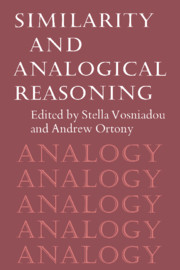Book contents
- Frontmatter
- Contents
- Preface
- List of contributors
- Similarity and analogical reasoning: a synthesis
- Part I Similarity and the structure of concepts
- 1 Similarity, typicality, and categorization
- 2 Similarity and decision making
- 3 Intraconcept similarity and its implications for interconcept similarity
- 4 Two-tiered concept meaning, inferential matching, and conceptual cohesiveness
- 5 From global similarities to kinds of similarities: the construction of dimensions in development
- 6 Comments on Part I: Psychological essentialism
- Part II Analogical reasoning
- Part III Similarity and analogy in development, learning, and instruction
- Afterword: Comments on Parts I, II, and III: A framework for a theory of comparison and mapping
- Name index
- Subject index
5 - From global similarities to kinds of similarities: the construction of dimensions in development
Published online by Cambridge University Press: 22 October 2009
- Frontmatter
- Contents
- Preface
- List of contributors
- Similarity and analogical reasoning: a synthesis
- Part I Similarity and the structure of concepts
- 1 Similarity, typicality, and categorization
- 2 Similarity and decision making
- 3 Intraconcept similarity and its implications for interconcept similarity
- 4 Two-tiered concept meaning, inferential matching, and conceptual cohesiveness
- 5 From global similarities to kinds of similarities: the construction of dimensions in development
- 6 Comments on Part I: Psychological essentialism
- Part II Analogical reasoning
- Part III Similarity and analogy in development, learning, and instruction
- Afterword: Comments on Parts I, II, and III: A framework for a theory of comparison and mapping
- Name index
- Subject index
Summary
is similar to functions as little more than a blank to be filled …
Goodman, 1972, p. 445Introduction
We compare objects to each other in a variety of ways. We experience our world in terms of a complex system of distinct kinds of perceptual similarities. We judge objects to be similar or different. We also judge objects to be similar and different in part – to be, for example, similar in color and different in size. We categorize objects by their attributes and in so doing judge them to be similar; for example, we categorize objects as red, as blue, as big, as small. We compare objects in terms of their direction of difference – judging, for example, one object to be smaller than another. This variety of kinds of judgments clearly indicates that perceptual similarity is not one thing but is of many interrelated kinds. In brief, we seem to possess a complex system of perceptual relations, a complex system of kinds of similarity. The concern of this chapter is with the development of a system of knowledge about such relations.
The evidence suggests that an understanding of perceptual relations develops quite slowly during the preschool years. Indeed, working out a system of perceptual dimensions, a system of kinds of similarities, may be one of the major intellectual achievements of early childhood. The evidence for an emerging dimensional competence is widespread – and includes developments in Piagetian conservation tasks (e.g., Piaget, 1929), in seriation and transitive inference tasks, in classification tasks (e.g., Inhelder & Piaget, 1958, 1964), in transposition learning (e.g., Keunne, 1946) and discriminative learning tasks (e.g., Kendler, 1979).
Information
- Type
- Chapter
- Information
- Similarity and Analogical Reasoning , pp. 146 - 178Publisher: Cambridge University PressPrint publication year: 1989
Accessibility standard: Unknown
Why this information is here
This section outlines the accessibility features of this content - including support for screen readers, full keyboard navigation and high-contrast display options. This may not be relevant for you.Accessibility Information
- 63
- Cited by
